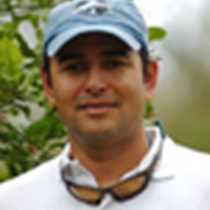Santa Cruz Island
This island, the second largest of the Galápagos archipelago, is the operation center of many tour boats. Any given day of the week it is possible to see many tour boats anchored at Academy Bay. This painteresque bay was named after the schooner Academy that brought the California Academy of Sciences to the Galápagos in the early nineteen hundreds. This renowned institution visited the Galápagos in two occasions, 1905-06 and in 1936 as well.
We spent the morning visiting the installations of the Galápagos National Park Service and the Charles Darwin Research Station. We learnt about the different successful conservation programs that have been running for many years in the Galápagos. Among these programs, one that our guests enjoyed the most is the one that deals with the incubation, rearing and repatriation of giant tortoises in captivity. First we observed baby tortoises. We paid a lot of attention to the babies from Santiago Island for we feel these little ones are ours. Lindblad Expeditions adopted Santiago Island providing vital funds for its ecological restoration. This is a great example of how a responsible tour operator can give back to conservation of its area of influence.
In the afternoon we went out to find these primitive reptiles in their natural habitat. We indeed did it with a lot of success for this time of the year is one of the best to see giant tortoises in the wild. They are migrating toward the highest parts of the islands looking for fresh water and vegetation. It was wonderful to watch them slowly moving around or feeding. Afterwards we went to a different location, Los Gemelos, where we observed a native cloud forest dominating the landscape. Around these interesting geological formations we found many species of epiphytes hanging on trees. These conditions are ideal for they provide great habitats for some species of the famous Darwin finches. We were lucky to find as well the most colorful land bird species in the Galápagos, the Vermilion Flycatcher. The late afternoon told us that it was time to comeback to the National Geographic Islander to continue with our expedition, this time towards the western realms of the Archipelago.
This island, the second largest of the Galápagos archipelago, is the operation center of many tour boats. Any given day of the week it is possible to see many tour boats anchored at Academy Bay. This painteresque bay was named after the schooner Academy that brought the California Academy of Sciences to the Galápagos in the early nineteen hundreds. This renowned institution visited the Galápagos in two occasions, 1905-06 and in 1936 as well.
We spent the morning visiting the installations of the Galápagos National Park Service and the Charles Darwin Research Station. We learnt about the different successful conservation programs that have been running for many years in the Galápagos. Among these programs, one that our guests enjoyed the most is the one that deals with the incubation, rearing and repatriation of giant tortoises in captivity. First we observed baby tortoises. We paid a lot of attention to the babies from Santiago Island for we feel these little ones are ours. Lindblad Expeditions adopted Santiago Island providing vital funds for its ecological restoration. This is a great example of how a responsible tour operator can give back to conservation of its area of influence.
In the afternoon we went out to find these primitive reptiles in their natural habitat. We indeed did it with a lot of success for this time of the year is one of the best to see giant tortoises in the wild. They are migrating toward the highest parts of the islands looking for fresh water and vegetation. It was wonderful to watch them slowly moving around or feeding. Afterwards we went to a different location, Los Gemelos, where we observed a native cloud forest dominating the landscape. Around these interesting geological formations we found many species of epiphytes hanging on trees. These conditions are ideal for they provide great habitats for some species of the famous Darwin finches. We were lucky to find as well the most colorful land bird species in the Galápagos, the Vermilion Flycatcher. The late afternoon told us that it was time to comeback to the National Geographic Islander to continue with our expedition, this time towards the western realms of the Archipelago.




